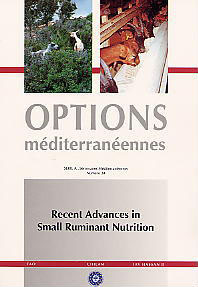| Article précédent | p. 99-102 | Article suivant |
Use of olive by-products in the nutrition of lambs in southern Tunisia
Three diets based on olive by-products (air-dried leaves, crude cake, crushed branches) and one diet based on oat hay were distributed to 4 groups of 12 lambs after weaning. Additional 200 g of concentrate were given to each animal during the two months of experimentation (May and June) which was carried out at the Arid Land Institute at Medenine (South-east of Tunisia). The mean daily feed intake of leaves, hay and crushed branches was 53.0; 53.7 and 57.3 g dry matter (DM) per kg metabolic weight (P0.75), respectively. However, it was only 8.2 g DM per kg P0.75 with olive cake distributed at will with a limited quantity of hay. This could be attributed to the age of lambs (young) and-or the high oil content which becomes rapidly rancid and makes the food less appetising. The lambs growth was poor or nil in all groups because of the low concentrate and nitrogen levels in the 4 diets. The olive by-products as well as hay covered the animals maintenance requirements. Better growth could be obtained with higher concentrate ratios. Then, in olive growing regions it is useless to look for supplies with hay (expensive with poor nutritive value) because the olive by-products could be an effective substitute.
- [ Afficher ]
- [ Télécharger ]
- [ Exporter la citation ]
Vous pouvez télécharger la citation au format :
- [ Imprimer ]
-
Mots-clés
AGNEAU, NUTRITION ANIMALE, SOUS-PRODUIT, SOUS-PRODUIT D'HUILERIE, TUNISIE, VALEUR NUTRITIVECiter cet article
Khorchani T., Hammadi M., Hammami H., Ben Rouina B. Use of olive by-products in the nutrition of lambs in southern Tunisia. In : Lindberg J.E. (ed.), Gonda H.L. (ed.), Ledin I. (ed.). Recent advances in small ruminant nutrition. Zaragoza : CIHEAM, 1997. p. 99-102. (Options Méditerranéennes : Série A. Séminaires Méditerranéens; n. 34). Seminar of the FAO-CIHEAM Network of Cooperative Research on Sheep and Goats, Subnetwork on Nutrition, 24-26 Oct 1996, Rabat (Morocco). http://om.ciheam.org/om/pdf/a34/97606122.pdf



